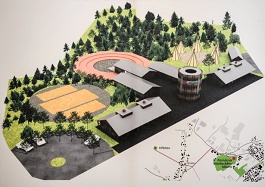
In Liberec, they plan to build a memorial based on a project by David Vávra
 |
A hundred years ago, around 50,000 prisoners, mainly Russian and Italian, lived in the camp. "That was how many residents Liberec had at that time; it was a city within a city. The camp occupied roughly 80 hectares and contained hundreds of houses, workshops, and the prisoners raised livestock, published newspapers, and even had their own currency," said archaeologist Petr Brestovanský from the Liberec museum.
However, today, little is known about the camp in Liberec. An upcoming project aims to change that, featuring a circular Chapel of Reconciliation with four crosses, one in each cardinal direction. The east is to symbolize the Russian prisoners, the south the Italians, the west the Austrian captors, and the north is to belong to the Czechs who released the last prisoners from the camp in 1919. The chapel is also intended to serve as a lookout tower for tourists. "As they walk behind the glass crosses, they create the illusion of fleeing figures, thereby fulfilling the past lives that have departed," Vávra outlined his vision.
The memorial is also planned to include a museum in the form of a replica of one of the houses where the prisoners lived. Visitors would inside see vividly what daily life looked like for the prisoners then. As a counterpoint, another house is intended to portray the life of a soldier from the present. The plans also include the possibility for visitors to experience life as a soldier during World War I, such as digging a trench or carving chess pieces. The restaurant concept is also unconventional. "It could offer dishes that soldiers ate in the early 20th century. Back then, it was poor food, but today it might be the basis for a healthy diet," Vávra stated. The concept also includes building an amphitheater and spaces for sports and accommodation.
A trilingual memorial plaque now commemorates the prisoner camp. It is located at today’s cemetery in Ostašov, where, a hundred years ago, the bodies of prisoners who died from infectious diseases were buried. According to Brestovanský, over 700 soldiers, mainly Russians, died from diseases.
The English translation is powered by AI tool. Switch to Czech to view the original text source.
0 comments
add comment










